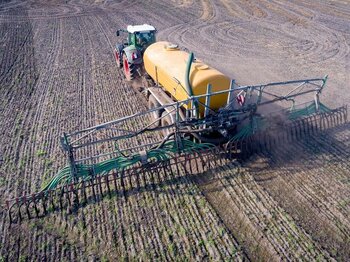Facts & Figures
Emissions of ammonia from agriculture
Roland Fuß, Cora Vos, Claus Rösemann | 16.03.2023
The emission of ammonia leads to the formation of harmful fine dust through reaction with other air pollutants. Via the input of nitrogen, ammonia also leads to the eutrophication of near-natural ecosystems. Through further conversion processes, ammonia emissions contribute to soil acidification, groundwater pollution and indirect emissions of nitrous oxide.
Within the framework of an international agreement on air pollution control (NEC Directive), Germany has committed itself to reducing ammonia emissions by 29% by 2030 compared to 2005. German ammonia emissions are largely generated in the agricultural sector. The agricultural ammonia inventory, reports annually the emissions from animal husbandry (stables, storage of farm manure) and soils (application of farm manure, mineral fertilisers, sewage sludge and other organic fertilisers; grazing). Agriculture alone emitted around 527 kilotonnes of ammonia in 2023. In contrast to the previous year, there was a slight reduction, which is partly due to lower mineral fertiliser quantities and partly due to a slight decline in the number of pigs and cattle. The Umweltbundesamt calculates the ammonia emissions of the other sectors and publishes them in the IIR (Informative Inventory Report). For 2023, these are around 42 kilotons of ammonia.
Emissions from animal husbandry
According to the current emission data from 2005, an upper limit of about 507 kilotonnes will apply from 2030. This increases the political pressure to take action to reduce emissions. As around 93% of national ammonia emissions in Germany currently come from agriculture, this sector is under particular pressure to adapt.
The most important source of emissions of ammonia in agriculture is manure. This incudes slurry, farmyard manure, leachate, but also digestate from biogas plants. Manure generally contains high amounts of ammonium nitrogen (NH4+) which can rapidly be transformed into gaseous ammonia, in particular on exposure to the atmosphere. In that way it discharges to the air and is lost as a nutrient for crops. Such losses occur in housing systems, manure storage systems and during the spreading of manure and have to be reduced as far as possible.
The most efficient and comparatively inexpensive way is to avoid losses when spreading farm manure. To do this, contact with the atmosphere must be kept as short as possible. This is achieved by spreading the fertiliser close to the ground in a band shape using a dribble bar followed by rapid incorporation into the soil or immediate incorporation using a slurry cultivator for liquid farm fertilisers on uncultivated arable land. If the fertiliser is applied to crops or grassland, incorporation in this form is not possible. However, there are injection or slurry methods for this purpose, which are rarely used in Germany.
In storage, emissions can be avoided by covering slurry and digestate stores as gas-tight as possible and by not storing the excrement in the barn, such as under a slatted floor. A floating sheet, for example, reduces emissions by 85 percent compared to an uncovered storage facility.
n barns for pig and poultry farming, ammonia can be filtered out of the air with exhaust air purification systems. Since cattle in Germany are mostly kept in freely ventilated loose housing, an exhaust air purification system would have no effect here.
Ammonia is also formed after the application of mineral fertilizers. The fertilisation with urea has a particularly high emission potential. A reduction of the emissions could be achieved if a different type of mineral fertiliser, such as calcium ammonium nitrate, were used instead of urea. According to the current Fertiliser Ordinance, since February 2020 urea may only be applied in combination with emission-reducing measures, such as the addition of urease inhibitor or incorporation within four hours.
More information:
- Calculations of gaseous and particular emissions from German agriculture 1990–2023: Report on methods and data (RMD) Berichterstattung 2025.
- The file belonging to the report with input data and emission results.
- New: county-by-county emissions of ammonia and air pollutants.
All available at https://www.eminv-agriculture.de/.






